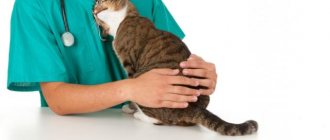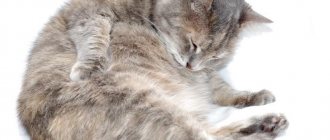With a superficial dive into the topic of the first mating of purebred cats, it seems that everything is simple and uncomplicated. All that is required of the owners is to bring the “groom” and “bride” together, and nature will do everything itself. But professional breeders have a different opinion on this matter, and beginners always have a lot of questions: when is it better to breed, where to do it, how to prepare a pet, what documents need to be drawn up and are they needed at all? I will try to cover the issue in as much detail as possible. Let's start with the most important thing - puberty and then go in order.
What is puberty?
Puberty in a cat occurs earlier than physiological maturity.
This is the stage of development of the reproductive system when a cat has the opportunity to become pregnant, and a cat can fertilize a female. Do not confuse physiological maturity and sexual maturity - the second occurs long before the full growth and development of the body is completed.
In females, sexual maturity occurs at six months of age, but there are cases of the onset of estrus at 4 months. It is logical that the first sexual heat is not a reason to untie the cat. Early pregnancy:
- inhibits growth and development;
- leads to the birth of a weak offspring;
- the period of gestation and childbirth itself is difficult;
- the pet may remain infertile.
One thing is obvious: if the cat is leaking, then it’s time to look for a manufacturer for the future, or better yet two or three, if the main candidate is busy at hour X.
How to determine pregnancy
Note that if a cat, after being at home, continues to behave as if in estrus, this does not mean that pregnancy has not occurred.
The first signs of pregnancy are visible after about 3 weeks:
- redness and swelling of the nipples;
- rounding of the sides.
Depending on the number of kittens, the time until birth can be from 55 to 68 days. The more kittens, the sooner the cat can be freed from the burden.
Note that indicators of pregnancy can also appear in the presence of a false version. In this case, it is better to show the animal to a veterinarian.
Also read the article on how to find out if your cat is pregnant and how long pregnancy lasts in cats.
What about cats?
Males become sexually mature at 8 months. During this period, it is quite possible to carry out castration if it was planned, but it is still too early to mate the cat.
Sexual use of the reproducer at such a young age:
- significantly slows down growth and development;
- negatively affects the development of appearance (habitus);
- worsens exterior characteristics;
- may cause impotence.
First mating
The first mating of a cat should be carried out at the age of at least 10 months.
You can breed a cat with a cat after the completion of basic growth and development and the complete formation of the genital organs. Only the fulfillment of these two conditions will make it possible to obtain numerous and full-fledged offspring without damage to the body of the expectant mother.
For cats, the ideal time for the first mating will be 10-15 months of age, but no later than one and a half years. Almost all breeders recommend skipping the first two heats and only then unleashing them.
Important! A cat should not give birth more than 3 times a year.
Late insemination is also undesirable - it can lead to disruption of the reproductive cycle with all the ensuing problems:
- false pregnancy;
- inflammatory processes in the uterus;
- polycystic disease;
- exhaustion;
- stress, etc.
Breeding use of males is permitted after the first year of life.
The period during which estrus lasts
If the cat is in good health, the heat will last about one week, perhaps a few days more. A cat's readiness for mating can be seen in changes in its character and behavior. She becomes very docile, affectionate, rubs herself and her tail begins to tremble. He starts running around the apartment looking for the cat. Meow loudly at night, disturbing the residents of the house from sleeping. If the owner has not brought the pet into heat with a partner, then this condition will gradually pass, but it will recur in a few weeks.
Mating rules for cats
If the owner’s goal is to give birth to high-quality, and most importantly, truly purebred offspring, then he must obtain approval for the choice of a male in the club from professionals.
Now according to the rules themselves:
- You should not use any drugs that affect estrus: hormones are your worst enemy, they lead to the development of serious diseases.
- The cat is looked for in advance through advertisements or at an exhibition, and during breeding - only in the club. If they cannot find a partner, they turn to professional breeders for help.
- By the time of mating (but no more than a year and no later than a month before it), the animal must be vaccinated against rabies, calicivirus, panleukopenia, rhinotracheitis, chlamydia and lichen (the last two vaccinations are not required).
- Two weeks before mating, treatment for worms is carried out.
- On the day of the newlyweds' reunion, both their nails are cut - this will help avoid injury in the event of aggressive behavior.
- You should not bathe your cat before meeting the cat - soap neutralizes the smell of natural pheromones that attract males so much.
In addition, the female must be neat, well-groomed, well-fed, with clean eyes, nose mirror and ears.
Preparation
Before breeding “sponsored” animals, it is necessary to undergo mandatory preliminary training. Without it, no self-respecting breeder will agree to cooperate with you.
What do these rules include? They look like this:
- All vaccinations against infectious and viral diseases must be included in the animal’s passport.
- Treatment for external and internal parasites is carried out approximately a week before the expected mating.
- Providing documentation confirming the breed (passport from the club) - this measure is necessary when it comes to professional pet clubs.
Rules for mating males
- Cat owners must fully control the mating process and monitor their pets.
- You cannot mate two virgins - one of the animals must be experienced in sexual matters in order to avoid psychological and even physical trauma for both.
- The owner of the breeder is fully responsible for the safety of the cat brought to the groom; he must introduce them, give the bride the opportunity to hide if necessary, so that she can get used to the new environment.
- Again, the inseminator must be well-groomed and healthy.
Contractual relationship
This point comes first for owners involved in breeding and selling pedigree animals. It's better to draw up an agreement. The breeders have a sample; the document must include all the mating conditions and the resolution of possible disagreements, which almost always happen.
The contract states:
- Timing of vaccinations for both parents.
- Length of stay of a female in someone else's house.
- Pedigree regalia and achievements of future parents.
- The responsibility of the cat owner to the cat owner, in other words, the groom's side is obliged to return the bride safe and sound.
- Terms of payment for the transaction (cash reward, choice of a kitten or an alternative option for the birth of one baby).
- Conditions for the distribution of kittens to new owners after they reach two months of age.
- Conflict resolution in the event of failure to conceive, the birth of a non-viable offspring, or its death before the age of two months due to some congenital pathology. All possible scenarios are discussed and recorded. This issue can be resolved in different ways: re-knitting for free, return of monetary reward, etc.
In all controversial situations, the owner of a cat may request an additional examination of someone else’s pet in order to prove the “innocence” of his ward in a failed pregnancy or the death of the entire offspring. But it is better to carry out such a check in advance and, in case of doubt, not to enter into a relationship.
A document is a document, but before mating, any of the parties to the contract has the right, and simply the obligation, to collect as much information as possible about the future partner:
- external examination of the applicant for visible defects: poor coat, emaciated appearance, incorrect bite, coloring, etc.;
- study of documents: veterinary passport, pedigree, club card, etc.;
- examination and assessment of previous offspring, if any;
- additional examination by a veterinary specialist who will or will not identify hidden pathology.
All received data must be included in the contract, which will protect you from litigation in the future.
Direct mating
In order not to miss the right moment, it is necessary to observe the cat’s behavior.
You can tell when a cat is in heat by the following signs:
- frequent purring;
- excessive affection or unexpected aggression;
- friction against various objects;
- trembling of the tail and its turning to the side when trying to stroke the animal in the croup area.
It is better to send the female to the cat on the third day after the first symptoms of heat appear. Together with the cat, they provide a toilet, food, dishes, and a carrier.
If the lady is ready to mate, then she herself fawns over the cat, exciting him with her behavior. At the beginning of acquaintance, mutual ignoring of each other, aggression and even fights are possible. At this moment, it is necessary to ensure that the newlyweds do not injure each other.
When understanding has been found in the couple and the owner is confident in future peace, the young people are left alone so that they can reunite in a calm atmosphere. The fact that mounting has occurred is judged by the changed behavior of the female: she does not swear at the cat, she lies down next to him, allowing him to take care of herself in every possible way. And during intercourse, heartbreaking howls can be heard from the room, after which the lady begins to lick herself intensively.
After a while, the man loses interest in his partner and the cat can be taken home, even if the signs of estrus have not completely disappeared. Be sure to inform the owner of the inseminator about the mating results after 3 weeks!
It is clear that the situation described above is an ideal scenario. But in reality, everything does not go so smoothly:
- there are calm ladies, and there are aggressive ones;
- there are impudent ones who suppress the male;
- there are cowards hiding in the corner.
All these moments must be perceived adequately, try to resolve, not force events and give the cat the opportunity to persuade the bride on his own.
Non-standard situations and their solutions
There are incompatibilities in the cat family. Some are easy to overcome, while others require help or immediate intervention.
- Size discrepancy: the female is larger than the male. The cat is not able to impregnate the cat, since an important part of the body rests on the back of the partner. In such situations, the cat is directed.
- During coitus, a cat falls on its side: a person must support the pet in the correct position, although experienced producers themselves manage to cope with the task in such an awkward position.
- The cat is not given. The case is complicated, and most often you have to retreat and look for another love, since it is the female who decides who will be the father of her future children. If there is an urgent need to obtain offspring from this particular union, experts advise inserting a special probe into the vagina, which provokes ovulation and the female has no choice but to surrender into the clutches of an unloved man. Another way to resolve a similar conflict is to lock the couple in a separate room and hope that love will happen.
- A cat in a new place suddenly loses signs of estrus. It's actually stressful. As soon as the animal gets comfortable, everything will resume. You may have to leave the female to live with the cat's owners for a while so that they become friends and get used to each other.
- The cat is not shedding, but she was brought to the male. There is always the possibility of error when unusual behavior of an animal is mistaken for signs of sexual heat. But you can't fool a cat! If he is indifferent to the opposite sex and does not pay attention to his new life partner, then rest assured that the wedding will not take place.
Second phase
You should not immediately try to pick up the cat, as this will most likely result in injuries - bites and scratches.
First, the cat is accustomed to your hand by placing it palm down on the floor; you can place the cat’s favorite toy nearby. You need to wait until the cat comes up and rubs itself on your arm or leg. In this way, she wants to make sure that the object present is not dangerous. If a person initiates contact, the animal may respond with an attack.
If the cat attacks, pick him up early
If the pet has given the go-ahead, the palm is slowly raised to eye level and held in this position for a while. Then they begin slow stroking. You need to stop before the cat gets tired of close contact with a person.
You should not drive away a cat if it climbs onto your lap, even when there is no time for tenderness. Then it will be more difficult to achieve such trusting behavior.
Advice for owners of expectant mothers and fathers
Rules for keeping males before mating
Before getting a breeding kitten, a future reproducer, answer the following questions:
- Do you need exhibitions and why?
- are you ready to visit them and attract the attention of potential brides;
- Do you have conditions for adopting a cat?
- how will you attract owners of the opposite sex and advertise the groom;
- Can you monitor the health and proper nutrition of the reproducer?
If most of the answers are negative, then it is better to immediately castrate the cat and close the topic of breeding once and for all.
If the answer is yes, you will have to adhere to the rules:
- Do not associate with cats of dubious reputation: those that give birth to sick kittens, defective coloration, suffer from sexually transmitted infections or are involved in inbreeding. All the trouble will fall on the groom, even if he had nothing to do with it.
- Do not overwork the cat: there should be a break of at least a week between matings; periodically they are allowed to rest for a longer period of time. Long downtime is also not welcome. In both cases, the quality of sperm deteriorates, and therefore the quality of the offspring.
- Periodically check and improve the health of the male.
- A few days before planting, introduce B vitamins into the diet, which have a positive effect on sexual function.
Behavior after mating
Sometimes there are cases where a cat after mating still continues to call the cat. Her behavior is actually no different from the mating season. Discharge in a cat after mating is quite normal, this happens very often.
After mating, she will look for the cat, call him, she may well refuse food and water, and even stop going to the toilet for some time.
There is no need to take any measures for about 2 days, the main thing is to ensure that there is always fresh water and food in the bowl, and the tray is clean. When the cat calms down, she eats herself and goes into the litter box.
When considering how a cat behaves after mating, it is also necessary to take into account the characteristics of its breed and character.
- For example, mating of Scottish cats occurs very quickly, taking 2-3 days.
- In some cases, pets may take several days to get to know each other due to their difficult nature.
- That is why you need to choose a determined and arrogant cat as a partner, otherwise the mating may simply not take place.
If a cat yells after mating, this is quite normal, her hormonal levels have not yet recovered to normal levels, she is still inviting the cat and looking for him. At this time, you need to leave the cat alone; you should not stroke it and calm it down, giving it affection; the owners only aggravate its situation, significantly prolonging its restless behavior.
Usually, restless behavior after mating lasts no more than 2 days; if after this period of time the pet has not calmed down, you need to invite a veterinarian home so that he can examine it and find out the cause and provide qualified assistance.
Rules for keeping expectant mothers
Requirements are similar to those of males. The owner is obliged:
- provide the animal with adequate nutrition;
- introduce vitamins and microelements, calcium and folic acid are especially important;
- maintain a normal weight for your pet (obese or malnourished animals are unlikely to become pregnant);
- do not overload the body with frequent pregnancies: twice a year is enough;
- monitor exercise: active physical activity will make the cat stronger, and pregnancy and childbirth itself will be easier;
- do not forget about education: only a well-bred mother can instill in kittens the basics of good behavior.
In addition, even before mating, the cat should be assessed by experts who will highlight its advantages, identify disadvantages, check the compatibility of two lines and, based on this data, help find a good sire. If you ignore the rule and do not receive a “ticket to breed,” then the kittens born are unlikely to be recognized as purebred.
In principle, that's all. If you have questions, ask in the comments. Read about what to do after mating and what problems there may be afterwards in the next issue.











